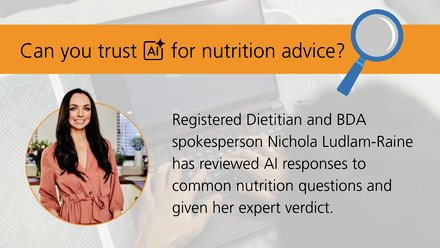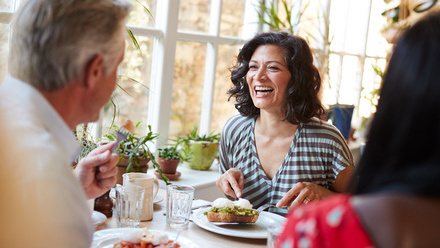Intuitive eating is a way of eating that helps you feel more connected to your body, both physically and emotionally. It focuses on listening to your body’s natural signals – like hunger, fullness and satisfaction – and making food choices without guilt or external rules.
If you are feeling stressed about food or experiencing chaotic eating, intuitive eating can support a more balanced and peaceful approach.
In this article, Specialist Eating Disorder Dietitian and Certified Intuitive Eating Counsellor Emma Townsin explains what intuitive eating is, how it works, and how to get started if it feels right for you.

How intuitive eating helps you tune into your body
Intuitive eating draws on three pathways that guide how we eat:
-
Instinct: hunger, fullness and satisfaction
-
Emotion: comfort, celebration and social connection
-
Rational thought: food, health and nutrition knowledge
When we rely only on rational thought (for example, by focusing only on nutritional content when following strict diets), we can ignore the other signals our body sends. This often leads to feeling disconnected or even in conflict with our body.
Understanding interoception: your body’s internal signals
Interoception is your ability to sense what’s happening inside your body - like recognising hunger or feeling full. These signals often start subtly, but if ignored, they can become intense and uncomfortable because our body is trying to get us to take action.
When we are less aware of, or ignoring, our body's messages through interoception, we may not notice the sensations until they are intense and we feel discomfort in our body and strong thoughts towards that need (such as food).
Intuitive eating helps you become more aware of these messages, so we can eat according to our body's needs peacefully rather than acting on urgent and intense needs which make us feel out of control.
The 10 principles of intuitive eating explained
The intuitive eating framework includes ten principles that either:
- Strengthen your connection to your body, or
- Remove barriers that block this connection
Here's a summary of the principles:
1. Reject the diet mentality
This is more than just stopping a diet. Understand how diet culture influences your thoughts about food and your body.
2. Honour your hunger
Learn how to recognise different levels of hunger and respond before it becomes overwhelming.
3. Make peace with food
Let go of restriction (which drives cravings and binges) and allow yourself permission to eat all foods without guilt.
4. Challenge the food police
Dismiss unhelpful thoughts that label food as "good" or "bad."
5. Discover satisfaction
If you are not satisfied you will keep craving food even if you are full. Learn how to feel satisfied with foods that feel good in your body.
6. Feel your fullness
Learn the right level of fullness you actually need to reach so you can stop eating at the right time for your body.
7. Coping with emotions
Recognise when it's actually helpful to turn to food when emotions feel difficult and explore other helpful coping tools.
8. Respect your body
Shift focus from controlling your body to caring for it, even on days you struggle with body image.
9. Enjoy movement
Move in ways that feel good – not as punishment or to burn calories.
10. Gentle nutrition
Make food choices that support health without feeling restrictive or rigid.
Can I trust my body?
If you feel like you can’t trust your body, it may be because hunger feels overwhelming, food causes anxiety, or you’re under stress. Iintuitive eating supports you in working through them by improving interoception to build connection and peace with the body's messages.
Proven benefits of intuitive eating for health and wellbeing
People who practise intuitive eating often report:
- A more peaceful relationship with food: Less guilt, fewer cravings and more enjoyment of life
- Improved body confidence and self-trust: Feeling more comfortable in your body and making choices that reflect your needs
- Better physical and mental health: Research shows improvements in blood pressure, cholesterol, mood and happiness
Is intuitive eating right for me?
Intuitive eating is designed to support people feeling stress, guilt or worry around food or experiencing chaotic eating behaviours. You may benefit if:
-
You've tried dieting or food rules but they no longer work for you
-
Your weight is fluctuates ('yo-yos') or you fear your weight will shoot up if you stop dieting
-
You feel disconnected from hunger, fullness or emotions
-
You feel guilt, shame, worry or second guess if you made the right choice after eating
-
You worry about food or body image often
-
You find yourself eating for comfort during stress or in the evenings
-
You want to stop feeling out of control around food
Use with caution if:
-
You currently have or are recovering from an eating disorder
-
You are neurodivergent (for example, autistic or have attention deficit hyperactivity disorder [ADHD])
-
You have a medical condition that affects how you connect with your body
Speak with a medical professional like your GP or a dietitian before starting. Intuitive eating can still be a great tool but it might look or feel a bit different (which is true to a lesser extent for all of us). You may benefit from working with someone with knowledge of both intuitive eating and your unique characteristics or medical condition.
How to start your intuitive eating journey
Intuitive eating starts with how you think and feel - the behaviour change follows naturally. Head to my Food Life Freedom website to access more information including Intuitive Eating Minis, bite-sized online courses designed to help you get started with simple, actionable steps.







